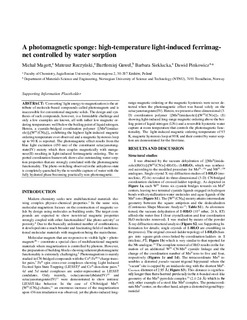| dc.contributor.author | Magott, Michal | |
| dc.contributor.author | Reczynski, Mateusz | |
| dc.contributor.author | Gawel, Bartlomiej | |
| dc.contributor.author | Sieklucka, Barbara | |
| dc.contributor.author | Pinkowicz, Dawid | |
| dc.date.accessioned | 2019-03-18T08:37:23Z | |
| dc.date.available | 2019-03-18T08:37:23Z | |
| dc.date.created | 2018-12-07T15:15:04Z | |
| dc.date.issued | 2018 | |
| dc.identifier.citation | Journal of the American Chemical Society. 2018, 140 (46), 15876-15882. | nb_NO |
| dc.identifier.issn | 0002-7863 | |
| dc.identifier.uri | http://hdl.handle.net/11250/2590389 | |
| dc.description.abstract | “Converting” light energy to magnetization is the attribute of molecule-based compounds called photomagnets and is inaccessible for conventional magnetic solids. The design and synthesis of such compounds, however, is a formidable challenge, and only a few examples are known, all with rather low magnetic ordering temperatures well below the boiling point of liquid nitrogen. Herein, a cyanide-bridged coordination polymer, {[MnII(imidazole)]2[WIV(CN)8]}n, exhibiting the highest light-induced magnetic ordering temperature ever observed and a magnetic hysteresis loop up to 90 K is reported. The photomagnetic effect results from the blue light excitation (450 nm) of the constituent octacyanotungstate(IV) moiety, which then couples magnetically with manganese(II), resulting in light-induced ferrimagnetic ordering. The reported coordination framework shows also outstanding water sorption properties that are strongly correlated with the photomagnetic functionality. The photoswitching observed in the anhydrous state is completely quenched by the reversible capture of water, with the fully hydrated phase becoming practically non-photomagnetic. | nb_NO |
| dc.language.iso | eng | nb_NO |
| dc.publisher | American Chemical Society | nb_NO |
| dc.title | A Photomagnetic Sponge: High-Temperature Light-Induced Ferrimagnet Controlled by Water Sorption | nb_NO |
| dc.type | Journal article | nb_NO |
| dc.type | Peer reviewed | nb_NO |
| dc.description.version | acceptedVersion | nb_NO |
| dc.source.pagenumber | 15876-15882 | nb_NO |
| dc.source.volume | 140 | nb_NO |
| dc.source.journal | Journal of the American Chemical Society | nb_NO |
| dc.source.issue | 46 | nb_NO |
| dc.identifier.doi | 10.1021/jacs.8b09322 | |
| dc.identifier.cristin | 1640459 | |
| dc.description.localcode | © American Chemical Society 2018. This is the authors accepted and refereed manuscript to the article. Locked until 30.10.2019 due to copyright restrictions. | nb_NO |
| cristin.unitcode | 194,66,35,0 | |
| cristin.unitname | Institutt for materialteknologi | |
| cristin.ispublished | true | |
| cristin.fulltext | original | |
| cristin.qualitycode | 2 | |
